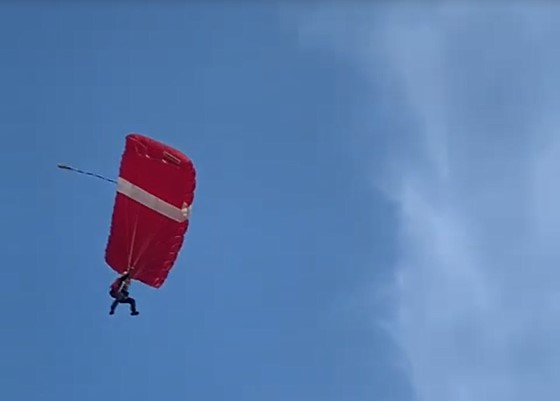On 9 August, a Red Lion was injured from a hard landing during a freefall display at the Singapore National Day Parade at The Float, Marina Bay.
The incident that happened around 6 pm drew attention and concern from the crowd watching the parade live and even audiences spectating online as Red Lion Third Warrant Officer Jeffrey Heng, the last of 10 parachutists, had a rough landing and tumbled on the ground.
Medical Channel Asia spoke to John P. Hart III, Skydiving Chief Instructor of Start Skydiving in Ohio, USA. He shared his insights on how the accident could have possibly occurred during the National Day Parade in Singapore. John is a United States Parachute Association Safety and Training Advisor and a professional demonstration skydiver on Team Fastrax who has performed more than 7,000 skydives over the past 18 years.
Source: WhatsApp
“In the video, it appears that the parachute was turning toward the right upon impact. Any turns made while under a parachute will result in a dive in the direction of the turn. This is why skydivers should avoid performing turns while too low to the ground. Whether the jumper was causing this turn, either intentionally or unintentionally, or whether this turn was caused by other factors such as turbulence or a parachute malfunction is not known to me and cannot be determined solely from this video.”
John adds that the shape of the parachute canopy as it approaches the landing seems to suggest that it was buffeted by turbulence.
He added, “The video also appears to show the jumper encountering some turbulence just before landing as the parachute was showing signs of buffeting, particularly on the parachute’s right side. Turbulence is not uncommon during demonstration jumps such as this one because of all the surrounding obstacles and varying terrain. I do not know the wind conditions of this jump, but higher winds are more likely to result in turbulence. However, turbulence can be experienced in light winds too. Encountering turbulence while under a parachute could affect the jumper’s ability to control the flight of the parachute on landing. If the parachute was partially deflated on the right side, even just for a moment (as the video appears to show), it may have caused the parachute to turn (and, therefore, dive) towards the right on its own without any input from the jumper. He advised “Typically, the best thing to do when flying through turbulence under a parachute is to fly at full flight speed, which this jumper appeared to be doing. This helps keep the parachute pressurized and inflated”
“If turbulence is encountered upon landing, the best response is to perform a Parachute Landing Fall (PLF) upon landing and flare the parachute to slow down the landing. Doing so can help reduce the impact of landing. While the video appears to show the jumper performing a PLF on landing, which likely reduced the chance of incurring worse injuries, it also appears that the jumper did not perform a flare to slow the landing down.

Image: A Parachute Landing Fall (PFL)
A flare would have likely reduced the impact of this jumper’s landing significantly and, therefore, may have reduced the chance of worse injuries. The reason why this experienced jumper did not, or possibly could not, flare is not known to me and cannot be determined from this video. It could be for reasons we cannot immediately see in this brief video such as a steering control line failure, but that would just be speculation to assume such a thing.”

Image: Example of a flare
John Hart added that the Red Lion jumper may have had his hands on the parachute’s front risers and have been using them to turn the parachute which could explain the buffeting seen in the parachute, causing it to dive. ”Front riser turns to allow the jumper to gain more speed on landing for a faster glide across the ground.” He added “Front riser turns to cause the parachute to dive and quickly lose significant altitude when performed. Because of this, front riser turns must be started and stopped while the jumper is still high enough to allow the parachute to level out so the jumper doesn’t impact the ground.”

Medical Channel Asia also spoke to Orthopedic Surgeon Dr Sean Leo for his thoughts on the possible injuries a parachutist may suffer from such an accident.
“A whole spectrum of injuries can occur. These may range from skin abrasions to joint sprains to ligament ruptures to bone fractures and severe life-threatening internal organ injuries. The type of injury sustained is often related to the amount of energy involved (the higher the speed of impact, the greater the energy transferred the greater the likelihood of severe injury) and the point of impact (depending on which part of the individual contacts the ground and takes the greatest transfer of energy).”
According to Dr Sean, the road to recovery will differ depending on the injury incurred. “Combined injuries involving multiple body areas or internal organ injuries are certainly more serious and can even be life-threatening. On the other end of the spectrum, simple skin abrasions can take a few days to dry up and heal. Recovery time is dependent on the injuries sustained”
According to Singapore’s Minister of Defence Dr Ng Eng Hen’s Facebook post, Red Lion 3WO Jeffrey Heng is now stable. “Suffered some injuries due to the hard landing, but no surgery required. He will need time and some rehab, but full recovery is expected.”












